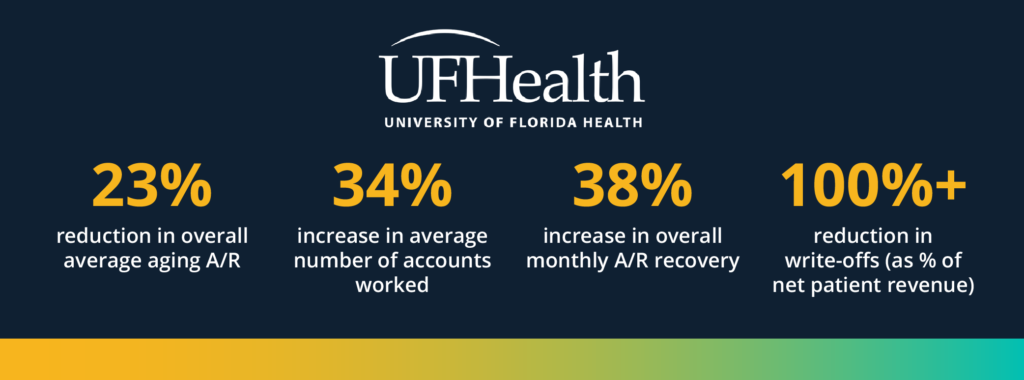
A significant amount of waste and financial loss within healthcare organizations can be attributed to inefficiencies within daily processes and programs. Realizing room for increased productivity within their revenue cycle management, University of Florida (UF) Health partnered with MedeAnalytics to catalyze change.
The Challenge
Two not-for-profit hospitals – UF Health Leesburg and UF Health The Villages – were renowned for their clinical procedures and outcomes, but struggled with unacceptably high denial rates, unreliable analytics and reporting, and very time-consuming A/R recovery processes.
The Solution
MedeAnalytics’ actionable, insights-driven and user-friendly revenue management platform catalyzed significant improvements in analytics and reporting capabilities, including:
- Real-time insights into important RCM opportunities
- Accelerated A/R recovery
- Clear A/R and denials trends, drill downs and causal analyses
- Proactive monitoring and optimization of A/R and denials
UF Health management also gained visibility into staff productivity and efficiency, as well as access to role-based, actionable reports and dashboards (enabling quick decision-making).
Measurable Impact
- 23% Reduction in Overall Avg Aging A/R
- 34% Increase in Average # of Accounts Worked
- 38% Increase in Overall Monthly A/R Recovery
- 100% Reduction in Write-offs as % of Net Patient Revenue
“MedeAnalytics’ self-service Revenue Cycle Management (RCM) offered the valuable tools and capabilities we needed to start making meaningful change. In less than six months, we saw significant advancements in A/R recovery, reduction in denials, and gains in revenue cycle staff productivity.”
– Leanzy Bailey, Corporate Manager of Denials and Audits
Watch the webinar to hear more from UF Health:
Get our take on industry trends
You’re asking too much of your EHR
Electronic Health Records (EHRs) are purported to do a lot of things to support healthcare providers, and most of their claims are generally accurate. Of course, like anything, there are many areas where EHR vendors could and should make improvements.
Read on...Gamification in healthcare only works if you can measure it – here’s how
In business and in sports, it’s all about teams. What teams can accomplish when they work together. How they can fail spectacularly when they do
Read on...Pandemic fuels 2021 healthcare megatrends
When I wrote about megatrends last year, the predictions were, naturally, forward-looking. Telehealth, for example, was important because of increased healthcare consumerism and the convergence of technologies to make its use quick and easy for payers, providers and patients.
Read on...Measuring provider cost and utilization
No matter the time of year, payers and providers should work to agree on a shared source of truth when it comes to data. With the recent end of the year, it’s time to celebrate the new year (who isn’t ready to say goodbye to 2020?) and close the books, which includes the reconciliation of any shared savings or losses.
Read on...


